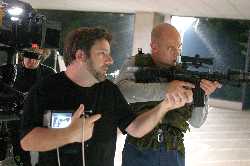|
From www.filmmakers.com Screenwriting You’re staring at a blank screen. Is this the hardest part of screenwriting? The beginning? What about the end? Not the end of the script, but the end of the process, when your vision becomes a reality in the theaters and homes of people all over the globe.
Second, distributors also love well-known actors. And actors love juicy dramas. Yet, distributors want you to avoid juicy dramas; they love genre pictures, remember? When actors read scripts, they look for parts they can sink their teeth into. Lou Diamond Phillips discusses what he looks for in a part: “First thing, I look at the obvious. Do I like this role? Is this something I see myself in? Is it something I can be good in?” As the screenwriter, you can give the script a better chance of success if you write characters that actors respond to. And if you can do that within a thriller or action genre, you stand an even better chance of getting your script noticed and picked up. Millican claims it is back story that helps bring the concept of tantalizing characters together with a thriller or action film. “With an action script, it’s easy to get lazy. To write one dimensional characters that are stereotypes from all the movies you’ve watched,” he confessed. “Usually my lead will have a strong backstory and be very interesting. And then after the early drafts I realize I’ve neglected the antagonist or the supporting characters. I go back and add backstory to make them more interesting.” When Phillips looked at “Bloodlines,” he saw something in the lead character he really liked. “He’s having this mundane conversation in the midst of fire fights. He punches the clock and he goes in to kill people and put himself in the line of fire. But he approaches it like a plumber. His tools just happen to be Desert Eagles and AK-47’s but he treats them like hammer and nails.”
And the other thing that intrigued Phillips was the relationships between the other characters. “A lot of times relationships are ignored in action scripts. But in this one that wasn’t the case. I had never met Tom Wright, yet on day one we had this wonderful rapport, this great back and forth that Dan’s dialogue certainly supported. It gave us a starting point where that relationship has become the kind of chemistry that you see between Mel Gibson and Danny Glover in Lethal Weapon. There’s an ease there. There’s a history that you don’t have to explain in the script. You just feel it.” And budget shouldn’t stop you from thinking you can’t get well-known actors. There are plenty of hungry recognizable actors out there that will work on low budget films. In addition, most educated investors (in films) will look at your cast attachments first because they understand how critical they are to the success of the movie. In “Bloodlines”, a SAG Modified Low Budget movie, in addition to Phillips, Millican was able to get veteran actors Yancy Butler (“Witchblade,” “Drop Zone”), Tom Wright (“Murder at 1600,” “Seinfeld”), Glenn Morshower (“Black Hawk Down,” “24”), and Jeff Speakman (“Perfect Weapon,” “The Gunman”). Why is this important to the writer? The nuances that go into a script are critical to an actor. Accepting a role is not always as simple to an actor as the amount of money offered and how available s/he is. Sometimes when the money is a little low and the conditions are a little rough, what attracts an actor might be more intrinsic to the project than just the deal memo. And knowing this in advance helps a writer to position a script to the actor’s wants. And finally, keeping your script simple in terms of locations and number of characters can go a long way in helping it become produced and distributed. The indie hit “Saw” (Cary Elwes) was filmed primarily in one location. Tarantino did the same with “Reservoir Dogs.” Millican approached “Bloodlines” with the same economy. “As I read the script,” Phillips claimed, “I knew that this was a film with a limited budget and was impressed with what Dan Millican was attempting to accomplish. He’s done something very smart in minimizing the locations and keeping the cast small so that what is on the page becomes achievable.” The odds of getting your movie produced can be increased with a script that is positioned to interest actors, to attract distributors and is easy to make. Market conditions dictate how much money will be spent and in the current market, less is the norm. To overcome some of the disadvantages of low budget shooting, starting with the right kind of script is critical. Typing your first sentence might get you past writer’s block, but including the right elements could get you into theaters or Blockbusters. The movie “Bloodlines” is expected to be released in early 2006. For more information on the movie “Bloodlines,” please go to: http://www.s-films.com For more information on Ted Chalmers and Movieplan, please go to: www.movieplan.net © Copyright 2003 by www.filmmakers.com |

